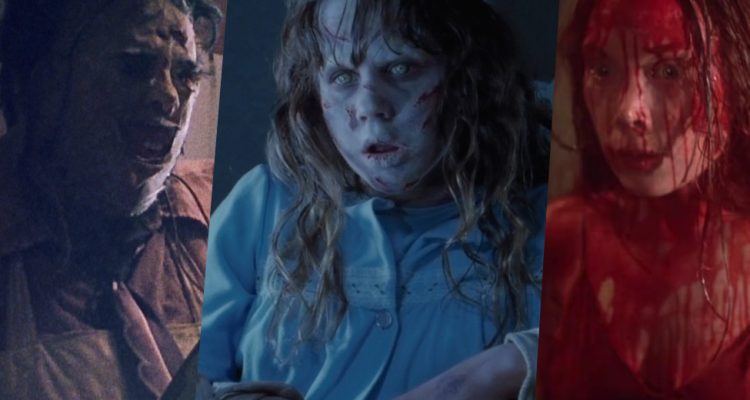
15. “Nosferatu The Vampyre” (1979)
Really just skimming the Bram Stoker source material for story beats, and taking cues from FW Murnau‘s classic rather than “remaking” it (not that we’re sure the director has it in him to do a straight remake, praise the lord), Werner Herzog delivered a masterpiece of his own with his take on the oft-filmed “Dracula” story. Estate agent Jonathan Harker (Bruno Ganz) visits Count Dracula (Klaus Kinski), leaving his comely his wife Lucy (Isabelle Adjani) at home to experience nightmares and some extremely toothy stalking. So the story is familiar, but Herzog’s heightened Teutonic gothiness and sensuous imagery gives it a fresh and beautifully doomy reworking that slowly and quietly builds its atmosphere of foreboding, which is punctuated in uncanny and supremely grotesque form whenever Kinski’s cold, corpselike Dracula is onscreen. Every Dracula actor brings something a little different, but of all of them, Kinski’s is the probably the most outright frightening.
 14. “The Tenant” (1976)
14. “The Tenant” (1976)
Made right off the back of his apex, “Chinatown,” and his last film before his sexual abuse of a 13-year-old girl the following year and his subsequent exile, “The Tenant” isn’t quite a straight-up horror (though it is definitely a cousin to “Repulsion” and “Rosemary’s Baby”), but it’s nevertheless a nervy, darkly funny film that finds some fascinatingly terrifying material in the mundane. Polanski himself plays a man who takes over an apartment, only to find himself tormented by his neighbors, who may have driven the previous tenant to jump off the balcony. The director doesn’t give easy answers as to whether the events are real or imagined, and that’s part of the genius of it: the film drops you into the mind of an increasingly anxious, troubled person, and the horror here isn’t in your face, but a gradual kind of gaslighting that has a far more insidious effect.
 13. “Eraserhead” (1977)
13. “Eraserhead” (1977)
A lonely man tries to care for a mutant offspring —a hissing, horrific distortion of a baby with an eerily blank face and wriggling tentacles— in a harsh industrial cityscape, while strange things go on behind his radiator… yes, describing the story of David Lynch‘s mindfuck debut is a fool’s errand. But like all surrealist narratives, this is a film to be experienced, not explained, to be freaked out by, not followed: there’s the alien, otherworldly vibe, and the intoxicating, heady, nightmarish imagery. Like being trapped in a crack between the real world and the inky uncanny, “Eraserhead” is not his greatest film, but it is a stunning calling card: a hymn to the freaks we all harbor inside, a desperately sad meditation on alienation and loneliness, and a nighttime tone poem to the darker sides of our psyches and our Fats Waller-scored introduction to one of cinema’s most radical, uncompromising directors.

12. “Invasion Of The Body Snatchers” (1978)
Remakes are often problematic, especially when they’re of a beloved classic, and both Abel Ferrera’s 1990s “Body Snatchers” and 2007’s Nicole Kidman/Daniel Craig disaster “The Invasion” proved just that when they completely botched the 1956 original “Invasion Of The Body Snatchers.” But Philip Kaufman’s 1978 re-do of the same material is one of the outliers, brilliantly updating the film for a new era and probably even improving on it. Again, the film sees ordinary folk —in this case, health inspector Donald Sutherland and his friends— begin to suspect that the general public are beginning to be replaced by eerie extraterrestrial replicas. But the film builds on the original rather than replicates it, and Kaufman actually squeezes more terror and social commentary out of the premise than Don Siegel originally did, with post-Watergate paranoia stepping in for Red Scare/McCarthyism Rorschach test of the original. And the final shot might be the most terrifying image on this whole list.
 11. “Hausu” (1977)
11. “Hausu” (1977)
There’s a good reason Nobuhiko Obayashi’s utterly insane and potentially insanity-inducing film also placed high on our Best Foreign Horrors Ever list. But it’s not necessarily that it has the most original premise. Reportedly (and somewhat obscurely) based on “Jaws,” it nominally follows the (mis)fortunes of six teenage girls staying over in a house that it not so much haunted as off its face on psychotropic substances. Part horror movie, part day-glo art installation, and part Scooby-doo episode, this is a maximist frenzy of a film which defies the boundaries of traditional horror, as how it defies the boundaries of traditional filmmaking. But gaining it a place in the horror canon nonetheless is the dizzy, deranged glee Obayashi takes in ripping reality apart to a preternaturally unsettling degree —for even the very few people in the midnight screening audience who aren’t high, this is a nightmarishly mind-bending trip.

